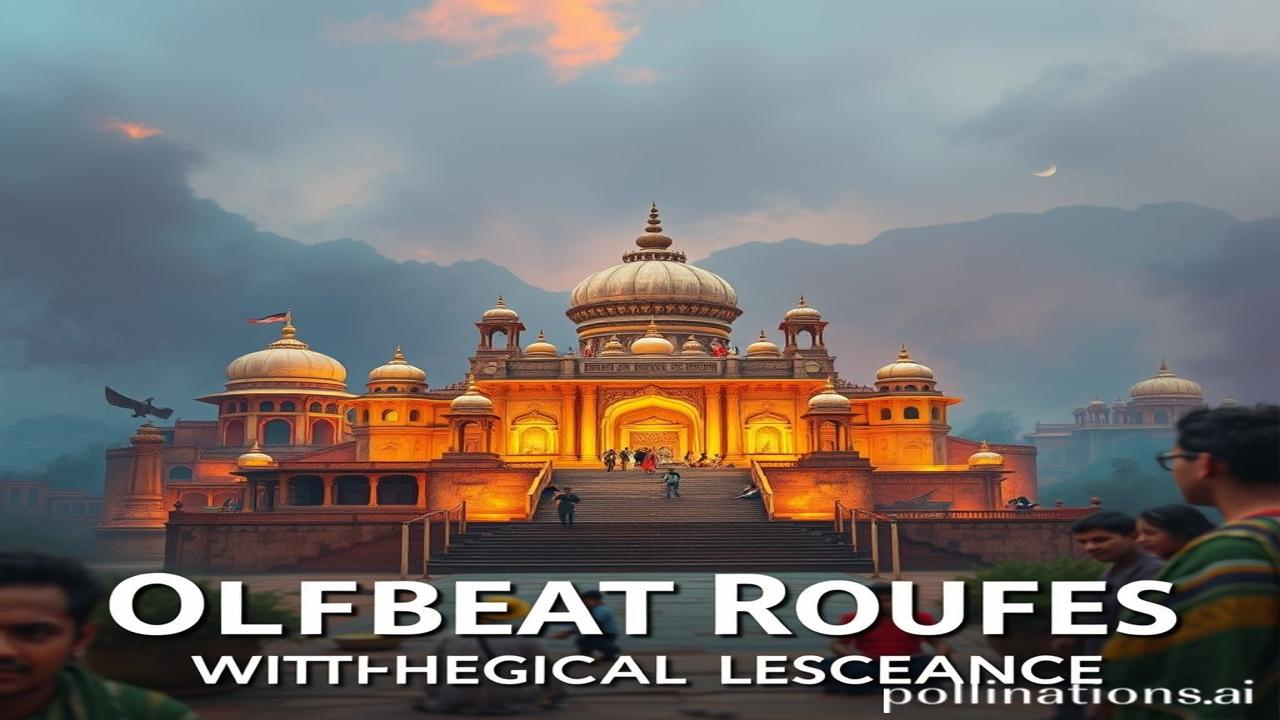Dhool Bhari Raahon Par: Uncovering Offbeat Pilgrimage Routes aur Unka Itihaas
Kabhi kabhi aisa lagta hai, jaise Bharat ki dharti ke neeche, waqt ki ek aur duniya chupi hui hai. Jahan har pathhar ek kahani kehta hai, har mandir ki ghanti ek itihas sunati hai. Hum aksar popular pilgrimage sites ki baat karte hain – Tirupati, Vaishno Devi, Amarnath. Lekin… kya aapne kabhi un raaston ke baare mein socha hai, jo kam jaane jaate hain, par itihaas se bhare pade hain? Aaj hum unhi dhool bhari raahon par nikalenge, jahan Bharatiyata ki sachchi rooh basti hai.
Offbeat Pilgrimages? Yeh Hai Kya Cheez?
Think of a pilgrimage, aur aapke dimaag mein shakti peeth, ya char dham ki yatra aati hogi. But offbeat pilgrimage routes are different. Yeh woh raaste hain, jahan shanti zyada hoti hai, aur logon ki bheed kam. Yeh woh jagah hain, jahan itihaas ki chaayaein ab bhi maujood hain, jahan ancient mandir, bhule-bisre gufaein aur forgotten monasteries milte hain. These paths often wind through rural landscapes, connecting you to the essence of India.
Kahan Aur Kab: The Historical Footprints
India mein, har state, har district mein aise hidden gems hain. Unki kahaniyan centuries purani hain. Rajasthan mein, Mount Abu ke near, Arbuda Devi ka mandir hai, jahan ke bare mein kaha jata hai ki devi ke hoth gira the. Karnataka mein, Badami caves hain, jahan early Chalukya rulers ne apna influence dikhaya. Odisha mein, Ratnagiri, Lalitgiri aur Udayagiri Buddhist sites hain, jo Gupta Empire ke baad flourish hue.
Kyun? The Importance of Hidden Narratives
Offbeat pilgrimages sirf religious sites nahi hain; they are windows into our past. These routes showcase the regional variations in art, architecture, and traditions. They offer a peek into the lives of the people who lived, worked, and worshipped here centuries ago. Yeh hamari cultural diversity ko celebrate karte hain aur hamein reminder dete hain ki Bharatiyata sirf Delhi ya Mumbai tak limited nahi hai; yeh har gali, har gaon mein basti hai.
Zameeni Sach – Log Aur Jeevan: A Journey Through Time
Imagine 10th century Gujarat. The Solanki dynasty rules, and Rani Udayamati is commissioning the Rani ki Vav stepwell in Patan. Can you picture the artisans, the stonemasons, their hands rough with labour, yet creating intricate sculptures of gods, goddesses, and apsaras? Ma Rukmini ne aaj naye kapde pehne, kyunki Rani ki Vav mein bada samaroh tha, aur woh bhi Rani Udayamati ko dhanyavaad kehna chahati thi, jinhone unhe pyaas se bachaya.
Ya phir, sochiye 7th century Tamil Nadu. Pallava kings ne Mahabalipuram mein shore temple banwaya. The waves crashed against the rocks, the fishermen cast their nets, and the temple bells echoed across the sea. Har shaam, young dancers mandir ke bahar nritya karte the, shanti aur bhakti ka mahaul banate hue.
Dharohar Aur Pehchan: The Echoes of the Past
Today, these offbeat sites still resonate with the echoes of the past. Rani ki Vav is now a UNESCO World Heritage site, a testament to the ingenuity and artistry of our ancestors. The Badami caves continue to inspire awe with their intricate carvings and architectural brilliance. The Buddhist sites in Odisha are experiencing a revival, attracting pilgrims and scholars from across the globe.
These places remind us that our identity is not just about the present; it’s about the legacy we inherit from the past. They reconnect us with our roots, fostering a sense of pride and belonging. Hum aaj bhi in mandiron mein unhi bhajano ko gaate hain, unhi rituaalon ko follow karte hain, unhi shlokon ko sunte hain jo hamare ancestors ne suney they.
Mazedaar Tathya Ya Bhram-Bhanjak: Facts and Fables
Log samajhte hain ki India ke saare mandir Hindu devi-devtaon ke hi hain… lekin asli sach yeh hai ki humare yahan Jain mandir bhi utne hi historical aur important hain! Dilwara Jain Temples on Mount Abu are a prime example, showcasing the incredible craftsmanship of Jain artisans.
Another common misconception is that these offbeat sites are not as important as the popular ones. But that’s simply not true. They hold invaluable historical and cultural significance, offering a unique perspective on India’s rich heritage.
Drishya Aur Bhavnayein: Sensing the Past
Imagine standing before the Rani ki Vav. The air smells of damp earth and ancient stone. The walls feel cool to the touch, each carving telling a story. The sound of trickling water fills the air, a gentle reminder of the well’s original purpose. You close your eyes, and you can almost hear the voices of the women who once drew water here, their laughter echoing through the centuries.
Ya phir, imagine standing on the shores of Mahabalipuram. The salt-laced wind whips through your hair. The waves crash against the rocks, a symphony of nature’s power. The smell of the sea fills your nostrils, and you can almost taste the salt on your lips. You look up at the Shore Temple, bathed in the golden light of the setting sun, and you feel a sense of awe and wonder.
Antim Vichar Ya Uddharan: Food for Thought
In offbeat pilgrimage routes, we find not just places of worship, but also pathways to understanding ourselves and our shared history.
As Sant Kabir said: “धीरे-धीरे रे मना, धीरे सब कुछ होय, माली सींचे सौ घड़ा, ऋतु आए फल होय।” (Dheere dheere re mana, dheere sab kuch hoy, mali sinche sau ghada, ritu aaye phal hoy.) Just like a gardener patiently nurturing a plant, we must explore our heritage with patience and respect, allowing its beauty to blossom in our hearts. Jai Hind!
